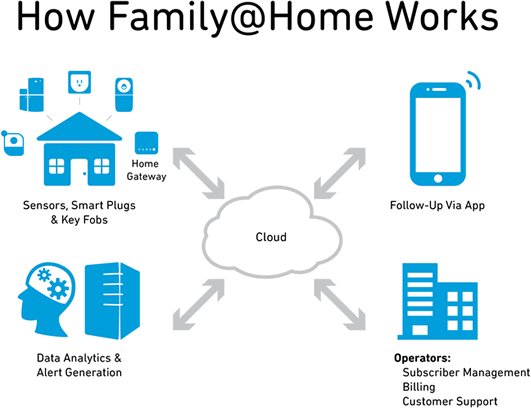What is SHaaS? And Why Should You Care?
A Comcast survey shows that homeowners want a smart home, but they want services, not a collection of connected devices. What do design engineers need to know about SHaaS when specifying interconnects for these systems?

In April 2016, Comcast released a report entitled, The Safe & Smart Home: Security in the Smart Home Era, compiled from surveys of almost 1,300 US consumers, that provided valuable insight into why customers are interested in smart home services, what features they really want, and how they plan to use smart home technologies.
The big takeaway from this report is that consumers want services in the smart home – or “smart home as a service” (SHaaS) – not a bunch of connected devices that remotely control various widgets and devices in the home.
What is SHaaS and How Does it Work?
First off, there is a big difference between a connected device and a smart device. Devices for the so-called automated home have been around for decades. For many years, solutions have existed that allowed a hobbyist or homeowner to remotely control the home’s doors, windows, environment, entertainment, etc. You (or your parents or grandparents) may remember the X10 communications protocol technology, which was able to wirelessly control a wide range of in-home devices.
Many of today’s so-called smart home devices are only slightly more sophisticated than X10 systems. Instead of, or in addition to, a local remote control, these devices can now be controlled over the Internet by a smartphone.
In some ways, these new devices may be even a bit less sophisticated than X10 because a single X10 controller could manage a variety of devices, whereas many of today’s smart devices each require their own app running on the smartphone. This means one app to control the home’s security, another for air conditioning and heating, and yet another for controlling the lighting. You get the picture; it’s not ideal.
To convert a basic connected device to a smart device requires three additional capabilities:
- It must connect to and communicate with other smart or connected devices in the home. The security system needs to exchange data and commands with the home’s environmental controls (i.e. heating and air conditioning), leak detection, lighting, entertainment, lifestyle, etc.
- It needs to be intelligent. More than being programmed to perform certain functions at certain times, a smart home solution needs to recognize what is going on in a home and learn what is normal, and when something unexpected happens, take action and/or send an alert to the residents, proper authorities, caregivers, or family members.
- All these functions need to be managed from a single application on a smartphone or any other web-connected device such as a tablet. Currently, most connected devices and appliances offer their own app to manage and control operations. However, end users will not want to shuffle through a screen full of various apps in order to find out what is happening in their homes.
Many of us have cluttered our smartphone screens with pages and pages of apps. It will be painful to add, configure, and manage a handful of additional apps that do not share a common user interface or even common commands and logic.
SHaaS as the Solution
Instead of a consumer choosing which hardware and software options to implement in their home, they can simply leave it up to the providers of home services. This includes the various operators who already provide internet access and entertainment to consumers and businesses worldwide. These operators already have relationships with homeowners – their routers, modems, and set-top boxes are already in the home, and the customers are already accustomed to paying a monthly bill for these services.
The market for providing SHaaS is not limited to just the service providers and operators. Numerous retail organizations like Walmart, Home Depot, Costco, etc., which already provide a certain amount of home services, could easily enter this market sector. Additionally, large security firms and integrators could market the entire suite of services to sell them as a unified package.
By opting for SHaaS, consumers avoid the major challenges outlined above. They don’t need to be technology geniuses. By having one organization responsible for installation, set up, and management, it makes it much faster to get the service up and running. In addition, if homeowners want to add additional services like family lifestyle or leak detection, they just need to contact their service provider. A service provider can ensure that all the controls and user interfaces are unified. All the SHaaS options can live within a single dashboard, with common commands and a similar look and feel. Finally, by providing an entire range of services, consumers do not need to know or even care about the underlying wireless connectivity technology.
By providing an ecosystem of smart home services to millions of customers, service providers don’t need to worry about which connectivity technology wins the marketing war.
Finally, consumers want services. Numerous studies have indicated that aside from a few early innovators and hobbyists, most people want the benefits of a smart home without the challenge of actually investigating, purchasing, installing, and maintaining a system of disparate connected devices. They want a system that simply works. You turn it on, you look at your smartphone’s customized smart home management app, and you can control and manage all aspects of the home. All from one app – one dashboard, not a collection of apps scattered across your smartphone.
As this market continues to grow, interconnect manufacturers will need to provide solutions that address system-wide connectivity in addition to the individual devices found in the home.
To read this white paper in its entirety, click here.
Author Cees Links is general manager of Qorvo Low Power Wireless and former CEO and founder of GreenPeak Technologies.
Intelligent Buildings and Smart Homes: Solving for Connectivity
[related_posts limit=”7″]




